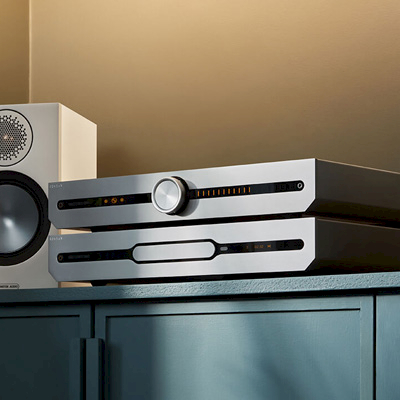A Guide to Hi-Fi Amplifiers
Date: 16th October 2023 Posted in: Company News and Events
Today, we will explain what an amplifier is, the key differences between types of amplifier, and how to choose the right one for your setup.
What is an amplifier?
Simply speaking, an ‘amplifier’ is an electronic device that increases (or 'amplifies') the power of an electrical signal to a level that can control a loudspeaker.
Hi-fi amplifiers are the beating heart of any audio system taking the quiet signals from your chosen source and making them powerful enough to drive any chosen loudspeaker. Choosing the right one is crucial to achieve the best quality and experience in your setup.

Pre and Power Amplifiers
There are two elemental stages of audio amplification: pre-amplification and power amplification.
The preamplifier (‘pre-amp’, or ‘pre’) is the first part. Taking low-level signals from various sources (e.g., turntables, CD players, etc.), giving the user the facility to choose between these sources and then buffering the choice for further processing. The preamplifier takes this buffered signal and layers processing options such as a master volume control, possibly tone controls or a stereo-pan left-right feature (balance). If you have a vinyl collection this requires extra stages in the pre-amp too.
Often a pre-amp will also incorporate a Digital to Analogue Conversion (DAC) allowing digital only sources to be enjoyed in the same way as your analogue favourites, this is an essential feature if your content is only available in digital format for connection to the amplifier.
The power amplifier (‘PA’ or the ‘power’ in ‘pre-power’) is the partnering stage of audio amplification after the pre. This provides voltage and current gain (power = voltage x current), enough to drive any speaker or headphone choice to produce sound, ideally.
Stereo Amplifiers
A stereo amplifier system is simply 2 channels of amplification, for the left and right side.


Integrated Amplifier
An integrated amplifier puts both of these amplifier stages under one roof. This can provide a more compact and convenient to use solution than a separates system, and consequently better value too.
If properly designed, an integrated amplifier should offer superior sound quality due to fewer connectors and cables between components and provide a more harmonious user experience. There are some potential drawbacks to consider, discussed later on.
Streaming Amplifier
A streaming amplifier builds on the basic functionality of an integrated amplifier, by including an internal audio streaming source which is conveniently app controlled to browse content (subscription required) as well as control the amplifier itself (volume, tone etc.).
The streaming amplifier opens up a whole new world of music discovery adding a layer of convenience hard to match in a ‘separates’ system.
Receiver
The term ‘receiver’ is sometimes used interchangeably with ‘integrated amplifier’, though they are not the same. A receiver is different in that it also contains a tuner for broadcast-radio reception. This functionality is all but replaced by internet radio services available from a streamer amp.

Considerations
When choosing the right amplifier for your setup, it is worth considering a few key factors before purchase.
Power:
An important consideration is the power output. This requirement ultimately depends on the size and sensitivity of your loudspeakers (how loud they are for 1 watt of input power). The drive units themselves vary in their power requirements due to their impedance, which is measured in Ohms. Between 4 and 16 Ohms is typical, lower impedances requiring larger current drive for the same power/loudness and higher impedance more voltage drive to produce equal loudness. The size of your room and distance from the loudspeakers themselves dictates a minimum power requirement for sensible listening levels.
Speaker power is measured in watts and there will be a maximum power specified for yours.
How to find a suitable power/integrated amplifier to match?:
An expert retailer will be able to advise a shortlist of pairings to be listened to. Alternatively, manufacturers may make specific recommendations based on their system knowledge providing a great starting point toward a suitable choice. The right choice is the one that sounds best in your environment, a home demonstration is, therefore, strongly recommended.
Price:
Price is a considerable factor in the amplifier choice. There is no ‘right’ amount to spend on your amplifier(s) all this depends on the functionality, type, power output and brand. Hopefully, this is a long term investment. Consider brand longevity with a service network to match as a reason to purchase alongside the performance criteria.
An audition with either your existing loudspeakers or the type on your purchase shortlist is essential regardless of budget.
Integrated amplifiers are generally more affordable and user-friendly than separate pre-power combinations. A downside to the integrated approach is possibly limited upgrade opportunities. It can be difficult or impossible without replacing the system entirely. It is possible, however, to upgrade an integrated amplifier with a second power amplifier if the pre-amplifier stage is designed with this in mind.
For dedicated audiophiles, a separate pre and power amplifier setup is often preferred to allow the greatest flexibility for future upgrades. However, it will cost more than an integrated system and may actually be at a disadvantage in terms of sound quality when comparing to an integrated for the same cost. You should carefully consider your future upgrade plans, so avoid paying for something you don’t need or factor it in from the start.

Regardless of your hi-fi amplifier requirements, Roksan offers a wide range of audio electronics that might just fit the bill.
This includes the versatile and multi-award-winning Attessa Streaming Amplifier, offering all the capabilities of an integrated amplifier with hi-res streaming through BluOS. Find your nearest retail store for an audition here, or online retailers here.



